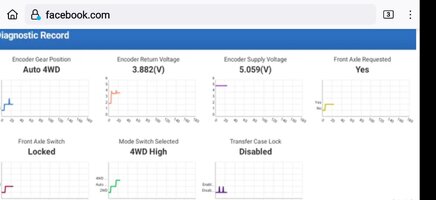So an owner on Facebook was testing his vehicle to see that the 4WD worked Ok. He spun his wheels a bit on gravel and felt like the fronts didn't engage.
So he get his scantool out and sees that with every shift to 4Hi the scantool shows the shift motor initially goes to 4Hi but then drops back and reports the encoder gear position at Auto 4WD even as the switch reports 4Hi. No warning lamps, no codes.
This led me to look into a few things. I have previously tested encoder return voltage readings against PID reported gearing positions and made the assumption that these encoder return voltage values don't change.
That assumption looks to be incorrect.
I have previously read that these TCCM 'learn' a range of shift motor position for the A4WD mode. I thought this applied to only the starting position for A4WD. I didn't realize that the higher end of clutch apply for A4WD might drift higher as clutches wear.
Tests today lead me to believe that the starting point for the A4WD mode of the shift motor is indeed a fixed point right about 2.86 volts (hex $92), but the point at which the range reported as A4WD vs 4Hi is a learned value.
This seems to have induced a condition in his vehicle where the 'system' by all outward dashboard displays is in 4Hi but the PID that reports the encoder range reports Auto 4WD.
I tested 6 different TCCM and no two of them agree at an encoder return voltage signal level to signify 4Hi vs A4WD.
For the high end of A4WD and the beginning of 4Hi I show anywhere from a low of 3.43 volts encoder return (hex $AF) to a high of 3.77 (hex $C0).
His graphs show even higher voltages being judged as "Auto 4WD".

And I can think of no reason his TCCM would initially go as high as 4.33 volts when switched to 4Hi but then right away drop back down to the neighborhood of 3.88 volts.
He switched the TCCM to his other TrailBlazer and saw the same results.
So he get his scantool out and sees that with every shift to 4Hi the scantool shows the shift motor initially goes to 4Hi but then drops back and reports the encoder gear position at Auto 4WD even as the switch reports 4Hi. No warning lamps, no codes.
This led me to look into a few things. I have previously tested encoder return voltage readings against PID reported gearing positions and made the assumption that these encoder return voltage values don't change.
That assumption looks to be incorrect.
I have previously read that these TCCM 'learn' a range of shift motor position for the A4WD mode. I thought this applied to only the starting position for A4WD. I didn't realize that the higher end of clutch apply for A4WD might drift higher as clutches wear.
Tests today lead me to believe that the starting point for the A4WD mode of the shift motor is indeed a fixed point right about 2.86 volts (hex $92), but the point at which the range reported as A4WD vs 4Hi is a learned value.
This seems to have induced a condition in his vehicle where the 'system' by all outward dashboard displays is in 4Hi but the PID that reports the encoder range reports Auto 4WD.
I tested 6 different TCCM and no two of them agree at an encoder return voltage signal level to signify 4Hi vs A4WD.
For the high end of A4WD and the beginning of 4Hi I show anywhere from a low of 3.43 volts encoder return (hex $AF) to a high of 3.77 (hex $C0).
His graphs show even higher voltages being judged as "Auto 4WD".

And I can think of no reason his TCCM would initially go as high as 4.33 volts when switched to 4Hi but then right away drop back down to the neighborhood of 3.88 volts.
He switched the TCCM to his other TrailBlazer and saw the same results.
